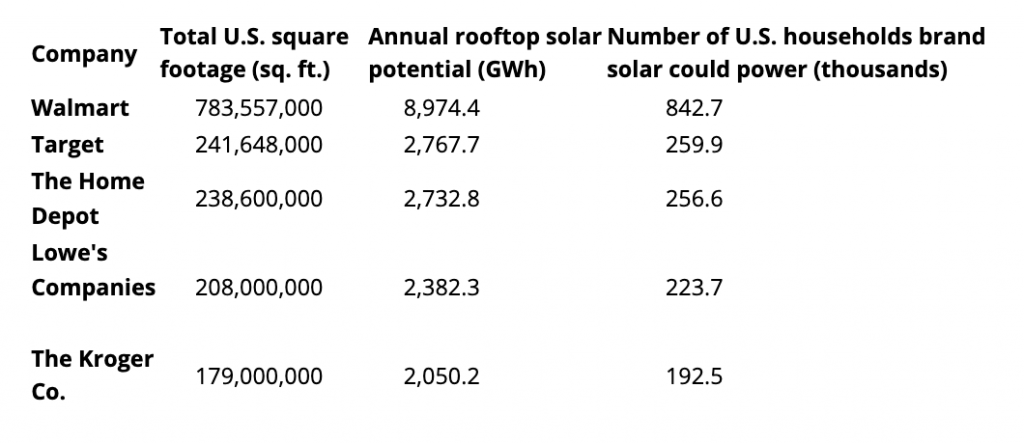By covering their roofs with solar panels, America’s big-box retail and grocery stores could generate enough clean electricity to power more than 7.9 million U.S. homes, according to a new report from Environment America Research & Policy Center and Frontier Group. The report, titled “Solar on Superstores: Big Roofs, Big Potential for Renewable Energy” also shows that comprehensive solar installation on big-box stores would cut greenhouse gas emissions equivalent to taking more than 11.3 million cars off the road.

Big-box stores and shopping centers could replace half of their annual electricity use by fully building out their rooftop solar potential, according to the report. Beyond delivering renewable energy that reduces global-warming pollution, the report finds that solar on superstores can provide numerous other benefits to local communities. These include helping build a more resilient electricity grid, significant cost savings, and better air quality.
READ: Could Solar Pay for Your Next Facility Roof?
“Rooftop solar is the best electricity source for the moment we’re in. It produces inexpensive clean energy that can be used where it’s generated,” said Susan Rakov, chair of Environment America Research & Policy Center’s clean energy program. “If we want a clean energy future, we should be deploying rooftop solar everywhere we can. Big-box store rooftops are right in the middle of most American communities, and they’re big, flat, and panel-ready.”
The report details national, as well as state- and company-specific, information for on-site solar potential. Overall, big- box stores can produce 84.4 terawatt-hours of solar energy. California has the most potential capacity, enough to power nearly 870,000 average homes, followed by Florida, Texas, Ohio, and Illinois. Among businesses, Walmart has more than three times as much annual rooftop solar potential as its next closest competitors. For that reason, Environment America Research & Policy Center launched a campaign last year to get Walmart to maximize its use of rooftop solar.

“The potential for Walmart to be a corporate leader on rooftop solar really stands out,” said Wade Wilson, an Environment America Research & Policy Center associate who leads the organization’s Solar on Superstores campaign. “If Walmart rises to the opportunity, that will set a standard for other big-box stores to dedicate their rooftops to solar too. And the more solar on rooftops, the more potential solar in our future, as costs keep coming down and adoption goes up.”
In addition to calling on companies to make strong solar commitments, the report recommends a number of public policies that would make ramping up solar on big-box stores more feasible. The highest priority is to extend and expand federal clean energy tax credits. Other important policy opportunities include expanding state and local tax incentives for solar; allowing producers to sell excess energy back to the grid; encouraging community solar programs; and streamlining solar permitting.
“Right now big-box rooftops have one function: cover the store. But that space has potential to do so much more,” said Johanna Neumann, senior director of the Campaign for 100% Renewable Energy with Environment America Research & Policy Center. “To reach our clean energy goals, we need strong public policy and committed private action. Big-box stores can be big leaders on the road to a clean energy future.”
Notably, many big-box retail stores are already reaping the benefits of both installing solar power on their rooftops and purchasing output from off-site projects. According to the Solar Energy Industries Association, the four companies with the most solar installed as of 2019—Apple, Amazon, Walmart, and Target—had on- and off-site solar installations totaling almost 1.4 gigawatts of capacity in that year. That’s more than 11% of the total commercial solar capacity installed in the U.S. as of 2019. Furthermore, as part of its own sustainability efforts, home furnishings giant IKEA currently has over 50 rooftop solar installations atop 90% of its U.S. locations.
Environment America’s “Solar on Superstores” report is available here.
